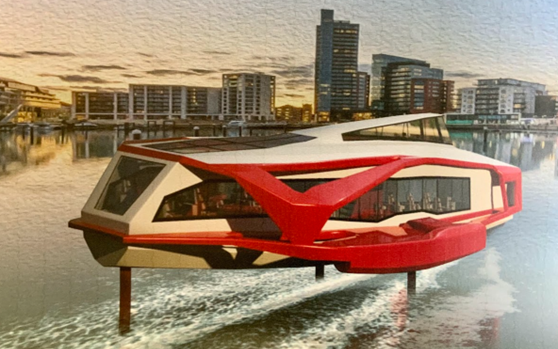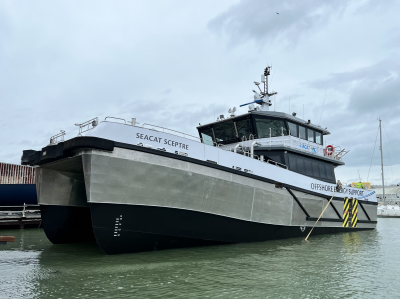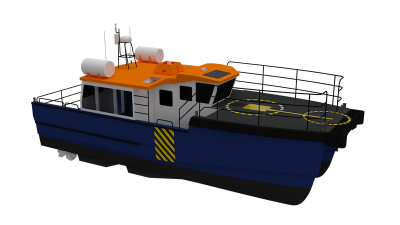Chartwell Marine announced on Oct. 17 that its electric foiling high-speed trimaran demonstrator has entered build at Designcraft Ltd, Southampton, U.K.
The $2.02 million project, funded by Innovate UK, is a partnership between Chartwell Marine, Solent University and Newcastle Marine Services to develop and build a scaled demonstrator for a simple and cost-effective zero-emission foiling fast ferry. The end goal of this collaboration is to support the decarbonization of short coastal journeys, which often run relatively empty during quieter periods of the day, while reducing operational costs for ferry operators.
“Foiling technology has great potential to significantly increase the range and viability of electric vessels, specifically in the passenger ferry industry, where routes, operations, and conditions are predictable and typically consistent,” said Andy Page, managing director, Chartwell Marine.
“However, for foiling to become widely adopted and viable at scale, components must be commercially available on short lead times and easy to integrate – for example, leveraging standard electric motors, commonly found in the automotive industry. Integrating these technologies in a marine platform is still in its early stages and requires rigorous testing to fully understand their potential and suitability. Addressing any technical hurdles is crucial before foiling technology can be deemed viable for industry-wide implementation,” Page continued.
“Key challenges include ensuring the vessel has enough power to reach the speed where the foils can start working effectively, without compromising battery life or overall performance. This demonstrator project aims to do just this and advance the industry’s understanding of foiling technology for commercial use,” said Page.
Chartwell highlighted the simple, yet sleek design, noting the 33’ demonstrator will feature a single fixed main foil, with the foiling and flight control carried out by a single foiling rudder. Chatwell stated the design enables the TriFoiler to foil with less power than either a monohull or catamaran-based design, offering commercial ferry operators a cost-effective option for building and operating the vessel.
Capable of reaching 18 knots, the demonstrator vessel is powered by twin 20kW motors with 60kWh battery capacity and can accommodate three people. A unique feature of the trimaran is that the batteries are positioned out wide on the craft, away from the passenger and crew area, which is intended to enhance safety and maximize useable space.
The TriFoiler is expected to hit the waters in early 2025 ahead of the Clean Maritime Demonstration Competition Round 3 (CMDC3) sea trials in March, aimed at proving the concept’s viability and its ability to operate in a range of weather and sea conditions. Prior to this, a full-sized digital twin is scheduled to undergo testing at the Solent University simulator to assess its handling, stability, and efficiency across various simulated environments.
Following the successful deployment of this demonstrator, the plan is to develop a commercial-scale vessel, based on the learnings gained from this project. Chartwell expects the final vessel to be a 78.5’ craft, capable of reaching 26-28 knots, with a capacity of up to 40 passengers. With approximately 300kW of installed power, Chartwell expects the vessel will be highly efficient, and buildable at low cost.
Andy Page continued, “Unlike many foiling vessels in the market which tend to rely on complex technology, our goal with this project has been to focus on simplicity and ensure that the design stands up to the realities of day-to-day commercial operation.”
“Chartwell has extensive experience bringing innovative concepts into commercial design, and as we continue to expand into the fast ferry market, we’re focused on delivering commercially sustainable solutions to decarbonize the industry. With the project entering an exciting phase, we look forward to working with Solent University to test the Tri-Foiler later this year,” Page said.





